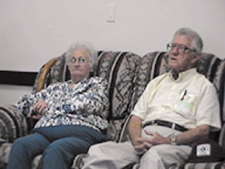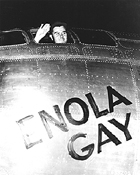|
“We
were put there as a dam to keep the Japanese from coming forward.”
|
|
 |
 |
|
"The
Story of an “Administrative Soldier"
|
|
|
-An
oral history of Jimmy Franks
|
Home | Table of Contents | Previous Story | Next Story
Personal Profile | Student Perspective | Audio Interview
|
Jimmy Franks did not plan on joining the Army after he graduated from Reagan High School in 1938. Instead he wanted to begin his college career. When he returned home for mid-term break in February 1941, however, he found a draft notice waiting for him. On February 26, 1941, Mr. Franks accompanied his brother, who was leaving to join the Army, to the recruiting office and told the officer-in-charge, “you might as well take me too.” The Army did not take Mr. Franks on that day, but on the following day he began five years of military service.
While
stationed on Tinian Island in the South Pacific, Mr. Franks experienced the
most memorable moment of his Army career. One day he decided to visit a nearby
B-29 base where he stumbled upon two very odd looking B-29 airplanes. Upon
closer inspection, he saw that their bomb bays were different from those of
the other B-29s. As Mr. Franks started to leave, sirens After the war ended, Mr. Franks returned to the U.S. to meet his wife-to-be, Doris, for the first time. For the previous four years the couple had corresponded through letters initiated by one of Doris’s older girlfriends. She had asked Doris and some other girls to write to young men in the service. By luck, Doris drew Jimmy’s name from a hat full of names and began writing to him. Shortly after meeting for the first time, Jimmy asked Doris to marry him. She said, “Yes,” and they married two months later. Mr. Franks’s experience in World War II ended happily. “We all came home,” says Mr. Franks of himself and his five brothers who served during the war. “We were real lucky.” |
 Because
Mr. Franks had acquired some clerical and administrative skills in college,
he was selected to be what he calls an “administrative soldier.” Upon completing
Basic Training, Mr. Franks was trained to be a company clerk. After training
and working under the command of General Eisenhower, Mr. Franks and his company
were sent to the South Pacific where he spent the next “38 months, 4 days,
and 1 hour.” He recalls leaving for the South Pacific from the San Francisco
Bay and heading “out underneath the Golden Gate Bridge.” As an “administrative
soldier” in the South Pacific, Mr. Franks’s main responsibilities were “to
supply the troops and to have the knowledge to tell them what to do.” In this
way, Mr. Franks worked “behind the fronts” as a part of the “dam to keep the
Japanese from coming forward.”
Because
Mr. Franks had acquired some clerical and administrative skills in college,
he was selected to be what he calls an “administrative soldier.” Upon completing
Basic Training, Mr. Franks was trained to be a company clerk. After training
and working under the command of General Eisenhower, Mr. Franks and his company
were sent to the South Pacific where he spent the next “38 months, 4 days,
and 1 hour.” He recalls leaving for the South Pacific from the San Francisco
Bay and heading “out underneath the Golden Gate Bridge.” As an “administrative
soldier” in the South Pacific, Mr. Franks’s main responsibilities were “to
supply the troops and to have the knowledge to tell them what to do.” In this
way, Mr. Franks worked “behind the fronts” as a part of the “dam to keep the
Japanese from coming forward.” went
off all around him. Suddenly, Military Police converged on him in their Jeeps
with “one guy driving and one guy standing up . . . with a machine gun aimed
at [him].” Mr. Franks demanded, “What’s going on here?” To which an MP responded,
“You tell me, mister.” After identifying himself, Mr. Franks was told to leave
the highly restricted area; but, as he turned to leave, he “looked up at the
nose of that plane and [saw that] it was the Enola Gay.” Mr. Franks still
remembers the shock he felt when “two days later those two planes bombed Japan
with the A-bomb.” He adds, “That was quite an experience for me.”
went
off all around him. Suddenly, Military Police converged on him in their Jeeps
with “one guy driving and one guy standing up . . . with a machine gun aimed
at [him].” Mr. Franks demanded, “What’s going on here?” To which an MP responded,
“You tell me, mister.” After identifying himself, Mr. Franks was told to leave
the highly restricted area; but, as he turned to leave, he “looked up at the
nose of that plane and [saw that] it was the Enola Gay.” Mr. Franks still
remembers the shock he felt when “two days later those two planes bombed Japan
with the A-bomb.” He adds, “That was quite an experience for me.”